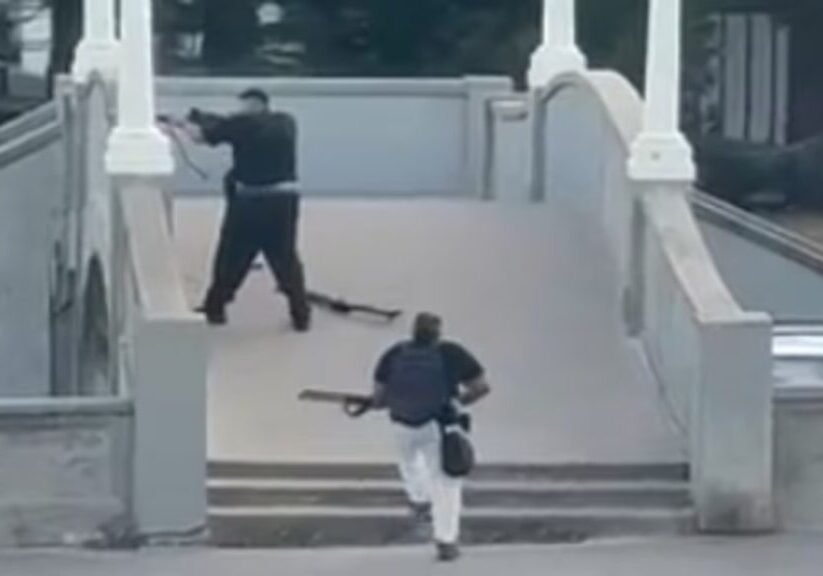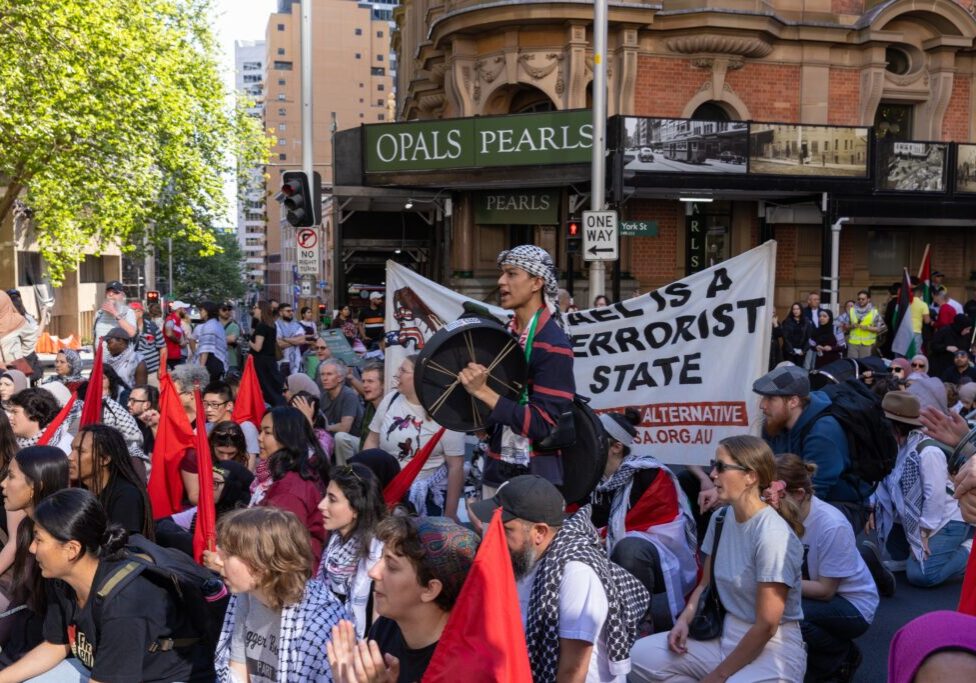Australia/Israel Review
Tunnel Vision
Aug 25, 2014 | Robert Ellenhorn

Inside Hamas’ audacious new terror strategy
Since Israel’s unilateral withdrawal from Gaza in 2005, and the subsequent take over of the strip in a violent coup by Hamas in 2007, Israel has faced an evolving threat from the coastal enclave. For most of that period, Israel’s primary security and strategic concern in regards to Gaza was preventing the build-up of Hamas’ rocket arsenal and finding suitable defence measures to protect Israeli civilians from the persistent rocket fire emanating from Gaza. The successful implementation of the Iron Dome defence system has today significantly blunted the strategic threat of rocket fire – though rocket attacks of course remain dangerous, disruptive and destructive. However, the most recent bout of Israel-Hamas fighting has indicated that Israel is now confronted with new strategic considerations in regards to Gaza – primarily the threat of Hamas’ terror tunnels.
The most surprising development during Operation Protective Edge was the discovery of at least 32 Hamas tunnels – many of these burrowing into Israeli territory, and equipped with electricity, weaponry and underground storage rooms and emerging near or even inside Israeli border communities. Hamas operatives attempted to infiltrate Israel via these tunnels on at least half a dozen occasions during the war and 11 soldiers lost their lives in these operations. Tunnel infiltrations helped prompt the Israeli ground operation in Gaza, launched on July 17 with the goal of discovering and destroying these tunnels.
While Hamas has a long and known history of using tunnels for various purposes, the existence of a broad network of attack tunnels is a substantial threat to Israel that will weigh heavily on its strategic thinking going forward. The constant fear of attack from below will now be at the forefront of Gaza-border residents’ minds and preventing infiltrations will become a major task of the IDF. One successful attack could result in hundreds of Israeli civilians slaughtered or the taking hostage of whole border communities.
Information corroborated during interrogations of captured Hamas fighters revealed an elaborate mass-scale attack was planned by Hamas to be carried out on Rosh Hashanah (Jewish New Year, falling on Sept. 25 and 26 this year), Israeli reports say. The attack reportedly was planned to involve hundreds of Hamas fighters emerging from dozens of different tunnel entrances at once, and would likely have resulted in unprecedented numbers of Israeli dead and/or kidnapped.
The revelation of these plans justifiably raised alarm amongst Israelis. As of writing, many Israeli border communities remain ghost towns, with residents fearing such nightmarish scenarios.
While not an entirely new phenomenon, the scale of the tunnel network on the Gaza border came as quite a surprise to Israelis. According to journalist Avi Issacharoff, before the operation the IDF figured Hamas had around 15 attack tunnels – “a major underestimate” in his words.
Dr. Eado Hecht of the Begin-Sadat Centre for Strategic Studies asserts that the tunnels “in themselves teach us nothing new on the political or strategic level”, but rather indicate a shifting of Hamas tactics.
He sees the tunnels as a new technique for terrorising Israelis as Hamas pursues its goal of destroying Israel, noting that Hamas’ preferred strategy in terms of cost and casualty rates was suicide bombings – a tactic now put to a virtual halt by Israel’s border defences. After the implementation of these defences Hamas turned to rocket attacks, now rendered less effective by the Iron Dome system and thus has now shifted to tunnel attacks which “are even less cost-efficient than rockets… BUT – any success of a tunnel attack, whether an infiltration attack or an explosion under a civilian or military target, could be extremely deadly.” Moreover, like suicide bombings, tunnels are highly effective at instilling fear amongst the Israeli population.
Hamas’ use of tunnels – how and why?
Tunnel warfare is nothing new. Despite its labour intensiveness and the specific military circumstances it requires – static lines or siege combat – its history in warfare dates from well before modern times.
It is believed that Jews used tunnels when fighting the Romans during the second century Bar-Kohkba revolt in Judea. Both sides in WWI used tunnels as a military tool to attempt to break the gory stalemate of trench warfare. During the Vietnam War, a vast complex of around 120 kilometres of tunnels under Saigon was used by Viet Cong forces to hide, as communication and supply routes, weapons caches, and even as living quarters.
The Gaza Strip has a long history with tunnels. Dating back to the days of Alexander the Great, tunnels have been employed for warfare and commerce in the coastal enclave. However, nowadays, Hamas-run Gaza has a few varieties of tunnel.
The most common sort of tunnel in Gaza reaches under the Egyptian border in order to smuggle weapons and goods into the blockaded coastal strip. Hamas levies taxes on goods passing through hundreds of such tunnels – serving as a main source of revenue for the group. Since the fall of Mohammad Morsi’s Hamas-friendly government last year and the emergence of the Abdel Fattah Al-Sisi-led government in Egypt, hundreds of Hamas smuggling tunnels have been destroyed by the Egyptian security forces, all but halting the once vast smuggling trade.
In addition to the smuggling tunnels, Hamas has built both offensive and defensive military tunnel systems underneath Gaza. Serving a variety of purposes, the defensive tunnels form an elaborate labyrinth underneath urban population centres. They are used for storing weapons, moving forces from one location to another, and perhaps most importantly, allow the higher echelons of Hamas’ military wing to reside in safety – free from the threat of the Israeli Air Force. It is believed that it is here that most of Hamas’ military and political leadership spent its time during Operation Protective Edge.
Offensive tunnels have been employed for multiple purposes as well. Initially, starting around 2001, tunnels would be dug under Israeli positions, filled with explosives and detonated. However this tactic is costly and – unless quite precise – yields low casualty numbers. While less common nowadays, one such attack occurred on the first day of Operation Protective Edge. Fortunately, the placement of the tunnel was imperfect and the explosion resulted only in the destruction of an empty home and guard-post in the village of Kerem Shalom.
The other sort of offensive tunnel is one that is used to infiltrate commandos who can utilise the element of surprise to stage attacks and seize hostages. Such an attack led to Israeli soldier Gilad Shalit being taken captive in 2006. The success of this attack – and the benefits reaped from the prisoner exchange deal it led to in 2011 – encouraged Hamas to continue constructing offensive tunnels and attempt more attacks of this nature. Handcuffs and tranquilisers were found in numerous tunnels discovered by the IDF.
Additionally, the lack of success in causing casualties through rocket fire during the eight-day Israel-Hamas bout of fighting in 2012 prompted Hamas to pursue alternative modes of inflicting harm on Israelis – increasing its tunnel capabilities drastically. The Morsi Government’s short stint in Egypt – allowing for the transfer of cement to Gaza – aided the improvement in these capabilities immensely. It is believed that much of the tunnel infrastructure found and destroyed by the IDF was constructed during the period of Egypt’s Muslim Brotherhood led government in 2012 and 2013.
The strategic purpose
Tunnels offer both military and other benefits for their patrons. The primary military advantage granted is the ability to move about undetected, invite the enemy into a dangerous underground environment, break enemy lines, and maintain an element of surprise. A single successful infiltration can result in hundreds of casualties or the taking of numerous hostages.
However, in addition to the military benefits of tunnels, they serve the purpose of instilling fear in the enemy population. The mere suspected existence of tunnels demands a constant level of heightened vigilance, knowing that even a brief relaxation of one’s guard can have deadly results.
Fear is certainly a key reason that many border Israeli communities remain nearly empty. The director of Kibbutz Be’eri reflected on this threat, saying: “We knew what to do with the missiles. The tunnels, it’s game-changing. We can’t do anything if the terrorists will come to our kindergarten. The tunnels, it’s very surprising, it can hit you don’t know where.”
The thousands of tons of concrete used by Hamas to build such a vast network of tunnels – much of it meant for the construction of civilian infrastructure – sends a clear message to both Israelis and Palestinians about Hamas’ intentions and long-term goals. It is estimated that each attack tunnel costs anywhere between one and three million dollars and that some 600,000 tons of concrete were used in constructing the tunnel network. The investment of tens if not hundreds of millions of dollars, as well as the human cost – one source says an estimated 160 chidren died building the tunnels – makes it clear that Hamas is not going to abandon its policy of focussing on terrorist violence anytime soon.
Looking North
Operation Protective Edge has also prompted the residents of Israel’s northern communities to call for a thorough exploration of the tunnel threat on Israel’s border with Lebanon.
Politicians and military personnel have also raised their voices about the need to be vigilant regarding the prospect of Hezbollah employing similar tactics to Hamas. While the hilly terrain of the north makes tunnelling more difficult than the sandy landscape of the Gaza border, geologists warn that a tunnel of hundreds of metres can be dug in mere months. Furthermore, while it may be harder to dig tunnels in such terrain, it is also harder to detect them.
However, Brigadier General Moni Katz of the 91st division – tasked with investigations of security threats – said in an August 4 meeting with northern residents that no tunnels have been found on the northern border to date and investigations had already been conducted. Yet, such declarations are far from a guarantee that Hezbollah attack tunnels don’t exist – in light of the reality that detection methods used in the past were proved inadequate to detect Hamas’ tunnels.
In fact, Hezbollah has claimed it has hundreds of booby-trapped tunnels in southern Lebanon as well as tunnels that stretch across the border. Some security analysts speculate that Hezbollah leader Hassan Nasrallah’s 2011 declaration that Hezbollah will invade Israel and ” take [the] Galilee” in the next round of Israel-Hezbollah fighting, could be a veiled allusion to the use of tunnels.
The Lebanese group has been using tunnels in a defensive capacity for at least twenty years. While there is no direct evidence of Hamas-style attack tunnels existing, one piece of indirect evidence suggesting a strong possibility of Hezbollah possessing such capabilities is its ongoing relationship with the North Korean regime – which has built perhaps the most sophisticated cross-border tunnels to date.
At least four tunnels have been discovered which run from North Korea into South Korea under the de-militarised zone separating the two nations. The North Korean tunnels reach over 70 metres into the ground and are wide enough to transport vehicles and supposedly infiltrate a whole infantry division in less than an hour. It is thought that over 20 more of these tunnels are in existence.
Hezbollah has a close relationship with Pyongyang. In the late 1980s and early 1990s Hezbollah operatives spent time in North Korea. Evidence of the partnership was also confirmed by the 2009 interception of a North Korean arms shipment, with weapons destined for Syria, Hezbollah and Hamas by way of Iran. The plane was forced to make an emergency landing in Thailand, whereupon the arms were uncovered and seized.
Furthermore, a recent US court ruling found the North Korean regime (along with Iran) liable for damages from rocket attacks on Israel during the 2006 Lebanon war by providing “material support and assistance to terrorists who fired the rockets at Israel,” according to US District Court judge Royce C. Lambert. Lambert also declared that the North Koreans had provided technical and other assistance to Hezbollah in constructing its underground tunnels and bunkers. The judge wrote in an 18-page report: “The models and parameters of these tunnels bear a very close resemblance to a network of tunnels in the demilitarised zone separating the two Koreas.”
The explicit goal of destroying tunnel infrastructure in Gaza thus also served Israel’s need to maintain deterrence against Hezbollah and other hostile forces in the region. Former Israeli Ambassador to the US Michael Oren stated, “The message … on the postcard to Gaza is not only addressed to Hamas; it’s addressed to Hezbollah, it’s addressed to other terrorist organisations, and it’s addressed to Tehran.” Oren warned, “If Israel proves incapable of dealing effectively with the tunnel threat, if it falls short of effectively deterring Hamas, everybody will draw a conclusion. And it’s a conclusion that we cannot afford to have them [draw].”
Looking forward
Looking to the future, the recent bout with Hamas will alter Israel’s security considerations substantially. The discovery of the tunnels has struck fear into the residents of southern Israel, leaving them with a lurking apprehension. As a resident of a southern Kibbutz put it: “It’s not a pleasant thought that you sit one day on the patio drinking coffee with your wife and a bunch of terrorists will rise from the ground.” Even if the immediate threat has been dealt with – something not yet confirmed (Hamas claims it still has numerous attack tunnels) – it remains alive in the minds of Israel’s southern residents. Hamas starting to dig again is also a strong likelihood.
Meanwhile, the same sort of threat – whether tangible or imagined – has manifested itself in the communities bordering Hezbollah-controlled southern Lebanon. Israel is therefore likely to make seeking a pro-active policy to deal with the tunnel problem a priority.
One of the obvious measures that will be taken to protect southern communities is the stationing of IDF soldiers in, and careful surveillance of, the border communities. However such a measure demands a permanent state of hyper-vigilance, is expensive, and is largely reactive. Thus, more pre-emptive measures will almost certainly be explored.
Knowing where entrances and exits to tunnels lie is the ideal way to counter the threat. However, such intelligence is incredibly hard to obtain as tunnel entrances have been found in homes, mosques and amidst other civilian infrastructure. Meanwhile, the exit shafts within Israel are often dug at the last minute to avoid discovery. Furthermore, reports have emerged that Hamas has executed dozens of tunnel diggers to prevent the possibility of intelligence about their work reaching Israel.
Thus, other modes of surveillance and prevention must be employed. According to Dr. Hecht, no reliable technology has been developed as of yet that can detect tunnels more than a few metres underground. As it stands, the deepest detection capabilities are about 10 metres and this must be done from virtually on top of the tunnel. He notes that “The Israel-Gaza border is a little over 60 kilometres long – looking for a 1.5 metre wide tunnel with the existing technology is like looking for a needle in a haystack.”
According to the IDF, since 2007, 300 million shekels (A$91.6m) have been spent researching and developing tunnel detection technologies, without any satisfactory results having been achieved. It is reported that some 700 different projects have been explored and thousands of experiments carried out.
One idea that has been floated is the building of a barrier under the ground to physically separate Israel from Gaza. The barrier would act as a sort of underground security fence, similar in purpose to the security fence constructed around the West Bank.
Israeli Justice Minister Tzipi Livni declared that “There are ways of doing it [separating Gaza from Israel].” She said. “The [barrier] may not need to be visible from above ground. There are, of course, also technological means that are being checked that could be effective.”
She also stated that despite the sizeable expense, “it will be worth it.”
However, some have argued that construction of a physical barrier will neither be worth the cost, nor a guaranteed solution. According to a senior IDF officer, such a barrier would cost upward of 20 billion shekels (A$6.2B). The high cost results from the length of the Gaza border – around 65km – as well the depth to which the barrier would need to be dug – dozens of metres into the ground. Perhaps the most effective barrier would be the construction of a moat, something that would require enormous resources both to build and maintain (fresh water would have to be used to prevent salination of the region’s underground water table). On top of the cost issue, the same senior officer noted that a barrier would not be “bypass-proof”.
On August 14, reports emerged about new tunnel sensor technologies that could potentially solve the problem. After failing operational tests eight years ago, detection systems have since undergone improvements and upgrades, the reports said. If the upgrades prove sufficient, the military would likely endorse the idea of deploying the system along the whole Gaza border. Such a deployment, while avoiding the costs of a full-sized barrier along the whole border, could still include the construction of underground barriers below sensitive parts of the border – either where conditions for digging are ripe, or near certain strategic outposts.
Whichever defensive measures are implemented, the threat is unlikely to disappear anytime soon. “Once the war is over and the IDF retreats back to Israel, Hamas can easily rebuild the offensive-tunnels again” says Dr. Hecht. He noted that this would take a great deal of money and a few years to complete but “the level of casualties suffered by Israel and the apparent terror caused by the tunnels to Israeli civilians …” means that Hamas can regard the tunnels “as a strategic success worth doing again.”
In other words, in the absence of Gaza’s thorough disarmament as a result of ceasefire arrangements, or better still, the end of Hamas rule of the coastal enclave, tunnels are likely here to stay as a major new challenge for Israel amongst its already difficult and multi-faceted security needs.






